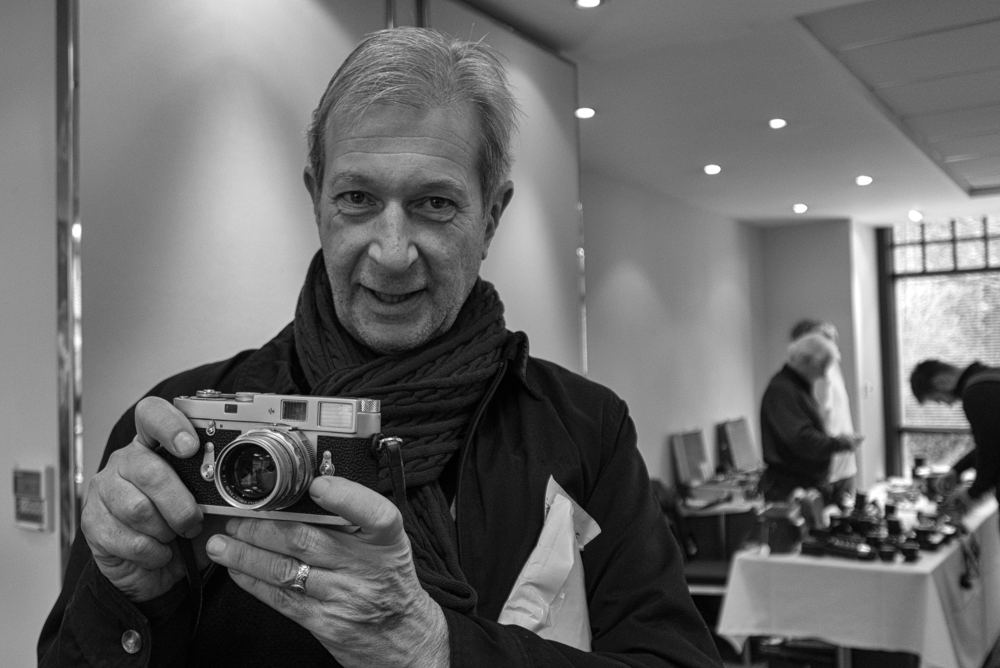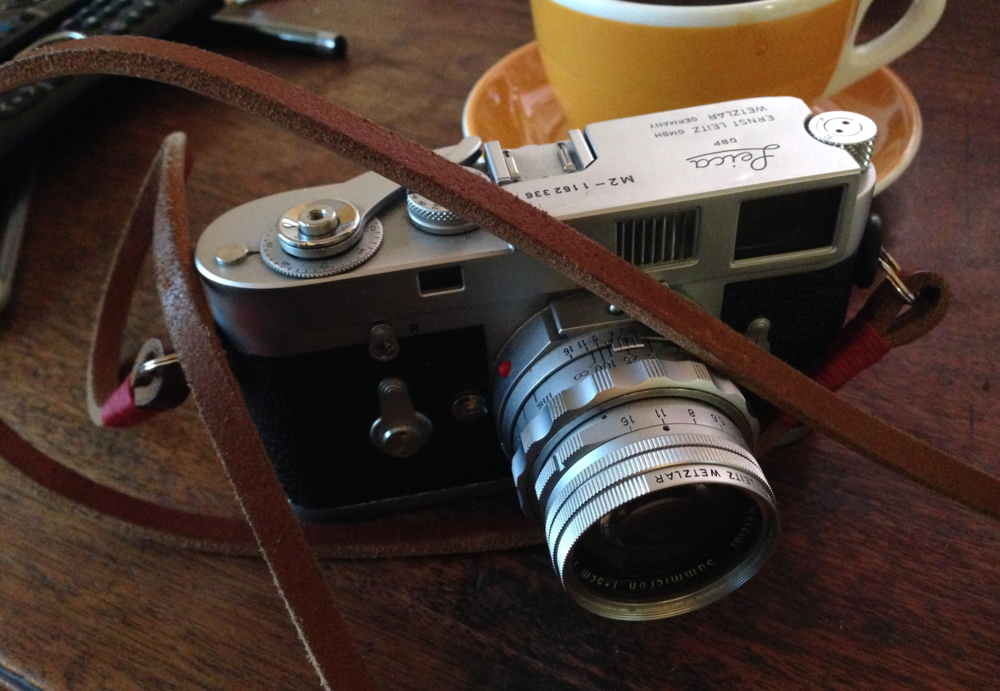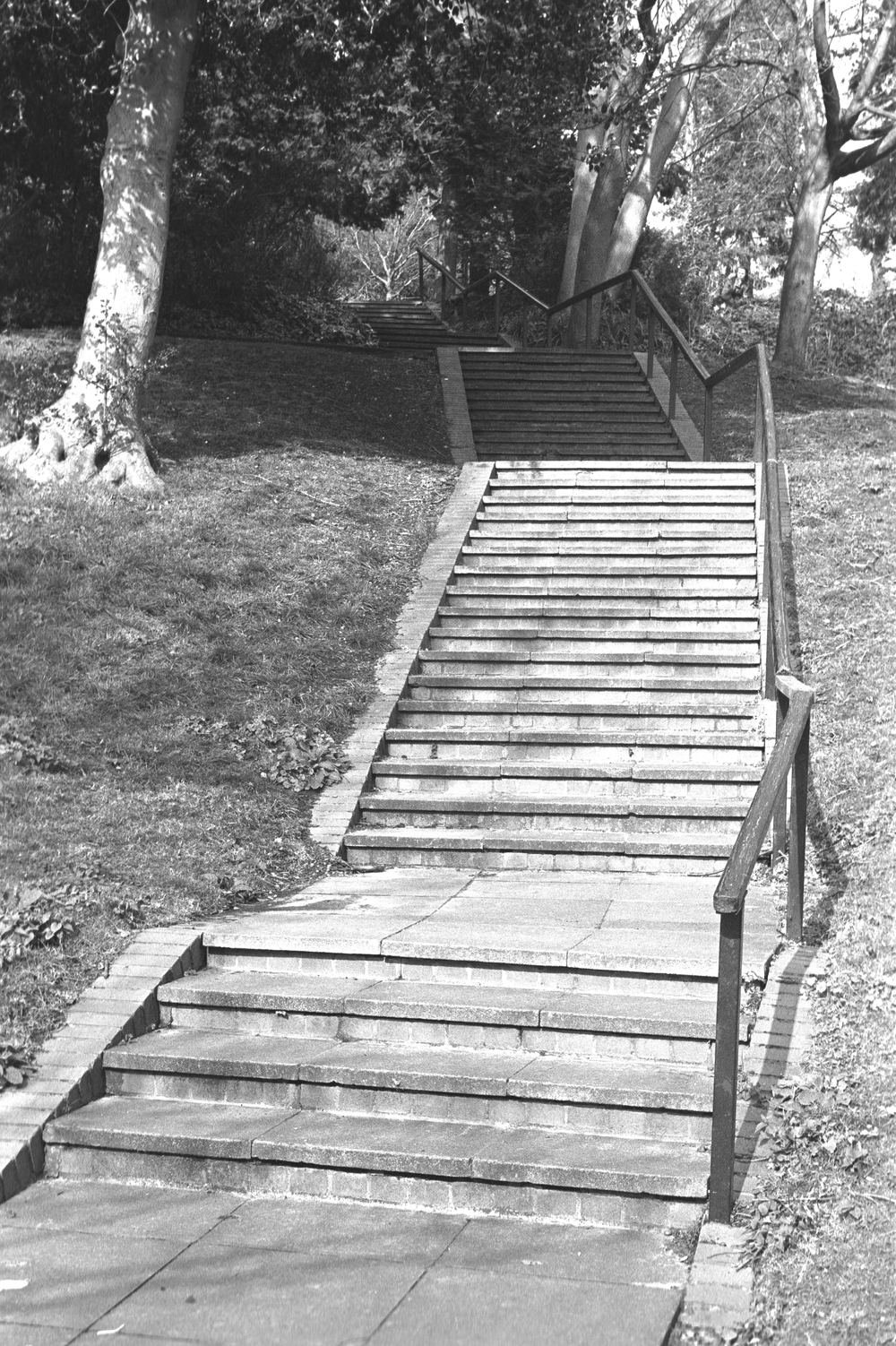
Reader Stephen Jenner, a prolific MacFilos commenter, has just finished his OCOLOY experiment. OCOLOY stands for one camera, one lens, one year. The original concept was set out my Mike Johnston of The Online Photographer: A Leica Barnack camera and lens, one roll of B&W film per week developed at Costco (for US participants) for one year.
It is certainly a tall order for most of us, even after we’ve ditched the doubtful allure of Costco and taken the roll to Boots. Stephen selected a Leica M2 and 50mm Dual Range—both of which he bought from Ivor Cooper at Red Dot Cameras—for his year of penance, if such it be.

He also bought a Nikon CoolScan and an old PowerMac. He tracked down a top-of-range quad core for £45 and the scanner, which only works with Leopard, was £500. This only runs (sounds like a helicopter, says Stephen) when he needs to scan a roll; he then transfer the lot to his MacPro. Stephen has discovered Iridient Developer to convert the .NEF (Nikon raw files) into JPG or other compressed formats.
Unfortunately, for a variety of personal reasons Stephen had to fall by the wayside after nine months. But it is still a marvellous effort, one that I cannot imagine myself emulating. Still, he is fairly happy with his OCOL9M foreshortened experiment:
What have I learned? I am glad that I gave up with film around 12 years ago–went from Nikon FM2 to Canon Digital Ixus, from Panasonic LX3, to Leica M8, Sony RX100, Fuji X100S, Ricoh GR(rrrr), finally alighting on the iPhone 3/5. Yet I really don’t like automated everything, apart from a light meter. I have found that I waste too many shots with sunny 16, or accessory meters. My composition has improved significantly. I am seeking to choose my shots, rather than become re-infected with digital diarrhoea, a good lesson.

We lesser mortals would find even the nine-month exercise difficult to manage. As William Fagan mentioned earlier this week, he is more an OCOLOD (one camera, one lens, one day) man. I can sometimes manage OCOLOW as I did last week in Athens. But, in a way, I was cheating because the D-Lux, admirable as it is, does not possess strictly OL, instead it has OZ, which is cheating because a zoom is many lenses in one.
No, to do this properly, you have to stick rigidly to OPM, one prime lens, as did Stephen. And, for instance, the irrepressible Eric Kim who constantly tells us how he shoots exclusively with the Leica MP and 35mm Summicron, year in year out. Eric, despite his obvious youth, is surely heading for OCOLODecade.
Minimalism in all forms is enticing, especially as I get older. I constantly downsize and I can really appreciate the one-camera-one-lens concept. Not only is it a pure objective, sensible in its own right, it is one of the best ways of improving your photography. You get to know the camera and its ways inside out and you can concentrate on the subject rather than the choice of gear or the settings.

Eric’s MP, or any Leica film camera for that matter, is perfectly suited to the task. With only three settings to consider—aperture, shutter speed and ISO (and, of course, ISO isn’t really a setting with a film camera, it’s a roll-by-roll advance decision) you are entirely free to concentrate on what you are doing.
Unfortunately, in my case, I do get tempted to try all sorts of different cameras. I tell myself that if I became an OCOLOYist I would have nothing to write about (except perhaps banging on nauseatingly about my minimalist credentials). On the other hand, I might have some better photographs to illustrate my non-writing.
It’s a hard choice. While OCOLOY and similar disciplines are superficially attractive, the final decision is a personal one. Some people like the discipline of focusing on one camera, others like the challenges of different tools for different jobs. It’s a case of horses for courses, I suppose.
- Subscribe to Macfilos for free updates on articles as they are published. Read more here
- Want to make a comment on this article but having problems? Please read this

I’m sorry but it should be about capturing a great image! It isn’t about being restrained by whatever so it becomes about what you use to capture the image but instead what is in your artistic eye! John VS
John,
I don’t disagree with you. Creating a great image is something we all aspire to (I keep reminding myself but it’s an elusive goal). While I have never tried OCOLOY or any other OYs for that matter, I can understand that getting rid of all the clutter and concentrating on the one camera/lens does have a cathartic effect. It’s all about clarity of mind and purpose. If this article encourages just one person to reassess his or or her photographic objectives, perhaps resulting in that great picture, then it will have served its purpose.
It depends on what you mean by “it” John?
As Hilary points out on her excellent blogs on her “One Project” and similarly the two Mikes, our host, and the one that set me running. “It” is not entirely about photography.
Hilary makes the point very early on that there are millions (perhaps billions) of images made each day around the world, many of them “great images”, none of them restrained, indeed many of them are the ego trips commonly known as “selfies”!
Human creativity is never held back by demonstrating a little restraint, it is only enhanced.
Mike and myself had been communicating via the Macfilos weblog and we met by chance at a collectible cameras fair, I heard him in conversation with a stall-holder, put 2 and two toogether, made foive and introduced myself, this was the result, we have all benefitted.
If (as I suspect) you are the JVS of “focal point inc”, I would have thought that you would be fascinated by the variety of people meeting here who play with lots of photographic hardware of all types and ages. My combination in the picture taken by Mike, is a sixty year old lens and 50 year old body. Hilary’s is an old Nikon FM2, which broke during the exercise and will no doubt be needing a CLA now, hence the 28, rather than the 36.
Many of the readers of this blog (not me, so far) have collections of photographic equipment dating from the 1930’s.
Mike even has the head of Leica reading his blog, Andreas H. Kaufmann, whose company along with what companies do, is devoted to longevity, quality and community.
So for me John, “it” is a very big subject and as Hilary’s project is especially pointing out, through the "one shot" exercise, which is then printed and shown in a gallery, we are meeting new people and finding out more about ourselves in the process.
I could write a lot more in regard to your “pithy” comment, but I will stop here and make the rather bold assertion that….
Watashi no hatsugen wa ijōdesu.
This is wonderful and a great thing to do. Love to see the results.
I have an exhibition showing in Canberra Australia called The ONE Project. The concept being, 1 camera, 1 roll of film, 28 photographers. Each photographer had 1 frame each to make a portrait and pass the camera on. The photographers involved found the process terrifying yet liberating .
The film was processed and prints made from each digital file, without any photoshop other than dust-spotting and normal adjustments for colour and contract.
The reason we only had 28 photographers is the camera had a technical issue two thirds of the way through the roll of film.
Anyway, we have had great reviews and is has been a successful exhibition.
I am currently making a photo book of the show and will blog the images and stories after the show is finished.
Thanks for your nice comment, Hilary. This is proving a very successful article and attracting lots of new readers. Your Canberra project is interesting–a completely different concept and I have to wonder where I could find 28 different photographers to expose one roll of film. Of course I could find 28 different cameras to expose one photographer but that’s not the challenge. I would be interested to see your blog when the article is posted. Please send a link. We could consider publishing the results.
It just occurred to me that this was over a year ago now and there might be a reply. There wasn’t so I went to have a look on Hilary’s website.
She posted the results here:
http://hwp.com.au/blog/the-one-project-headon-headon-photo-festival/
Interestingly, some of the photographers decided to remain anonymous, so 25 have names attached and three are anon.
Thanks for keeping us up to date, Stephen. I will do another small article to link to the results.
Excellent experiment Hilary… And you are absolutely correct, one shot and pass, that is particularly challenging.
Mike has picked out just two pictures of mine (I gave him about 10) from at least 40 rolls and I am not especially pleased with them.
I look forward to seeing your photo book, and will read your blog entries during the next few days. I remember seeing something a bit like this from Australia, can’t quite remember where, but it was one shot with a cheap pinhole camera, and there were some dreamy shots in that.
Perhaps we should start a campaign against digital diarrhea by slow motion, drip drip with a return to considered photography and printed output… 🙂
Yes, film would be better, but for me that is not an option at the moment, alas…
The move from Q to M: I traded an M9 for a Q, so I have (some) experience with rangefinders. I have to say, the Q was not a disappoint, it’s a wondefull camera. But… maybe it’s a bit too good. Taking decent pictures is too easy, too effortless. Call me a masochist, but I like to do at least some of the work myself, hahaha! And I don’t really like the evf on the Q. I prefer the ovf of the M. Anyway…
Hi Nico,
There is a digital variation of this self imposed course set out by Mike Johnston of the Online Photographer…
He featured a group of Italian photographers that were doing this…
A lot of people found that the "penance" of using film and a Barnack was going a bit too far… including me… I went for an M2 (not a Barnack), but then I went and added home processing just to add to the agony.
I was reading an earlier MacFilos article last night…
https://www.macfilos.com/photo/2015/1/6/how-i-lost-all-my-leica-equipment-and-what-happened-next
It was about a chap who had lost all of his really expensive cameras at the hands of a courier, the story ended with a really cheering conclusion, Leica replaced his lost jewels on a complementary basis…
But anyway, not the point of this little aside… The gentleman in question, pointed out that he had always been an ‘M’ user, and an M film camera is especially critical of the photographer’s skills…
I believe that I have been found out by it, but I have also learned, so it is a worthwhile exercise.
Hi Nico,
I hope Mike doesn’t mind but here is the link to Mr. Johnston’s digital variation…
http://theonlinephotographer.typepad.com/the_online_photographer/2014/11/one-camera-one-lens-one-year-the-digital-version.html
Hi Stephen, thanks for the link!
You have a good point, Nico. The Q is almost too good and I can understand what you mean. The EVF on the Q is the best on the market (at least it was until the SL came along) but I also prefer the rangefinder experience if I am pressed to make a decision.
OCOLOY is a great discipline which should lead to much better results. Digital makes us all lazy and indisciplined. I often feel that if I could get a decent scanner I would not use digital at all. The 50 DR is a wonderful lens which can only really be used on a film camera; you need its rigid Summicron brother for digital use.
Well done Stephen. I would like to see more of your photos if that is possible.
William
Thanks William, for my next trick, I would like to find a nice 35mm Summicron, so that I can use it on both the M2 and a digital M.
Michael has suggested that I try to produce something worth reading for MacFilos, so other mistaiks might find their way onto this domain, in the fulness of time.
Hmm, interesting… I am about to trade my Q for an M240 and I have only one M-lens (a Summarit 35). And no money to spend on other lenses for the foreseable future. Could this be the start of my OCOLOY? 🙂
Good idea and yes, it would be a good experiment except I think Stephen said it has to be a film Leica. But that doesn’t matter, it’s the object that’s important. Interesting move from Q to M and I’ll be interested in your comparison in due course.
Dear Michael,
It was great to meet you yesterday… I too will be interested in hearing how Nico gets on with the move.. The Q was a camera that I had been considering, but I am still hoping for a true digital M… A usable version of the M60.
I reckon that all of the ‘M’ cameras, try to get out of the way though, so an MM/M240/262/9 is just as good at this as a film M, perhaps without the longevity.
I want to make my own mistaiks, rather than have the camera flatter me.
I want to learn, rather than watch TV.